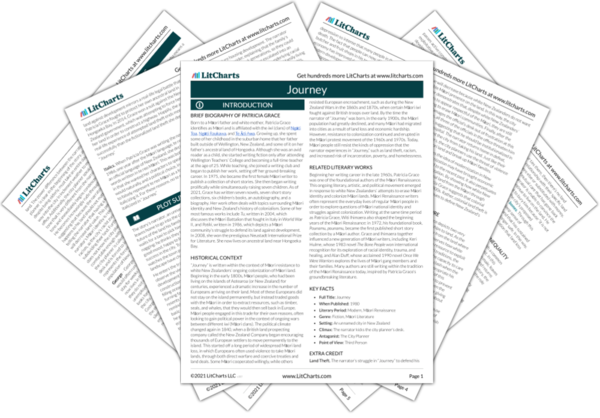Welcome to the LitCharts study guide on Patricia Grace's Journey. Created by the original team behind SparkNotes, LitCharts are the world's best literature guides.
Journey: Introduction
Journey: Plot Summary
Journey: Detailed Summary & Analysis
Journey: Themes
Journey: Quotes
Journey: Characters
Journey: Terms
Journey: Symbols
Journey: Theme Wheel
Brief Biography of Patricia Grace

Historical Context of Journey
Other Books Related to Journey
Key Facts about Journey
- Full Title: Journey
- When Published: 1980
- Literary Period: Modern, Māori Renaissance
- Genre: Fiction, Māori Literature
- Setting: An unnamed city in New Zealand
- Climax: The narrator kicks the city planner’s desk.
- Antagonist: The City Planner
- Point of View: Third Person
Extra Credit for Journey
Land Theft. The narrator’s struggle in “Journey” to defend his land against development mirrors a real-life legal battle that Patricia Grace fought to protect her own ancestral land in Hongoeka Bay. In 2014, Grace won a suit against the New Zealand government, which was attempting to force her to sell her land in order to construct a highway. Happily, the author’s real-life experience of attempted land theft ends more successfully than the fictionalized land theft she depicts in “Journey.”
Italics. When Patricia Grace was writing the novel Potiki in 1986, one year after the Māori language, te reo Māori, became an official language of New Zealand, she decided not to italicize words written in te reo Māori. This was both a stylistic choice, in that she wanted her characters to speak on the page as they would naturally, and a political choice, in that she did not want to falsely represent te reo Māori as a foreign language by italicizing it. For these reasons, no te reo Māori words are italicized in “Journey.”







